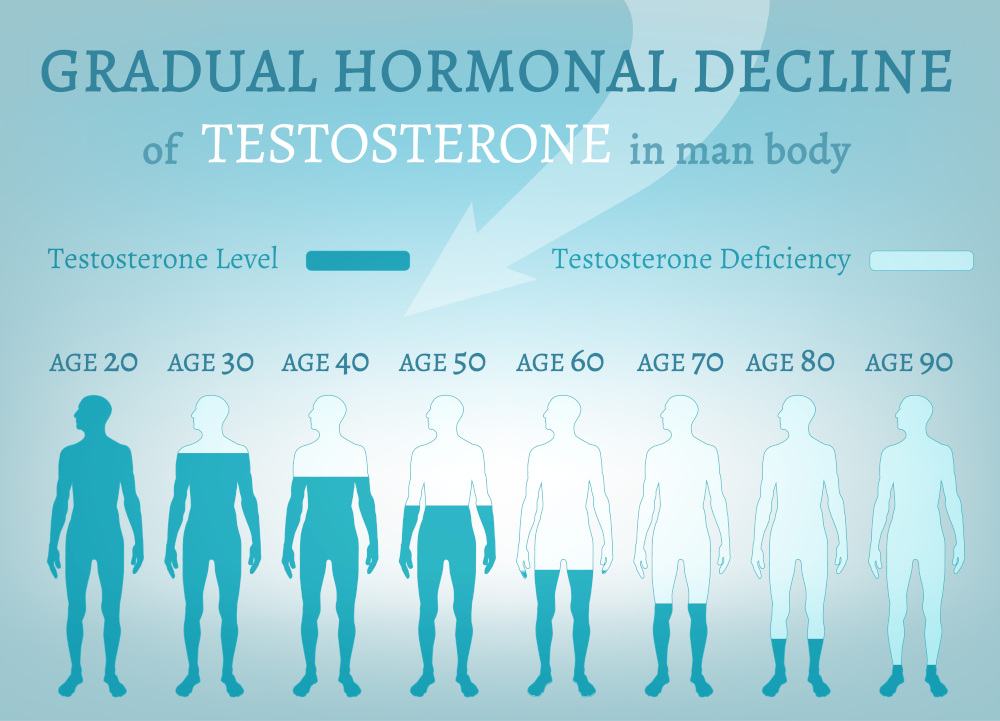
As men age, it’s natural for their testosterone levels to drop. Hormone replacement therapy for men can help hormone imbalance that might be largely affecting a man’s well-being. While there are risks to consider when contemplating hormone replacement therapy, it can be beneficial to boost male testosterone.
Different types of hormone replacement therapy, such as bio-identical hormone replacement therapy (BHRT), can improve the quality of life for males. Before deciding whether to proceed with replacement therapy, it is important to consider how it can help, as well as the pros and cons.
Causes of Hormone Imbalance
It’s no secret that male hormone levels drop with age. While there are circumstances where a drop in testosterone can occur earlier in life, this decline usually occurs around middle-age. At this time, testosterone levels reach a peak point in decline and can have a significant impact on a man’s life.
Men with a hormone imbalance may experience metabolic syndrome, a condition where men experience abnormal cholesterol and high blood pressure. These can both boost the risk of heart disease, stroke, and type 2 diabetes.
If a hormone imbalance occurs earlier in life or is a result of an infection or injury, this may be due to a condition called hypogonadism. This condition prevents the body from producing enough testosterone, which helps with male growth and development. Hypogonadism also prevents the body from producing enough sperm.
Reasons Men Should Consider Hormone Replacement Therapy
There are many reasons why hormone replacement therapy is beneficial to men. With a reduction in the risk factors related to metabolic syndrome, replacement therapy for men can help to improve their health and quality of life.
Many studies show how healthy testosterone levels—those between 300 and 1000 nanograms per deciliter (ng/dL)—are linked to a reduced risk of certain diseases. Specifically, hormone replacement therapy can help reduce the risk of heart attack, stroke, heart disease, and diabetes.
Higher testosterone levels can also increase energy levels, improve mood, and reduce anxiety overall. With hormone replacement therapy, men can have healthier weight control because the therapy reduces body fat and increases male strength and muscle mass. There is also the benefit of better bone density with aging and enhanced sexual performance.

Types of Hormone Replacement Therapy
If you want to pursue hormone replacement therapy to balance your hormone levels, there are a few different options that you can try. Ultimately, it is up to what treatment plan you are looking for and what your preferences are. Always consult with your doctor to find the hormone replacement therapy that is right for you.
- Testosterone pellets: These small bio-identical pellets are implanted under the skin. They then slowly release testosterone as your body needs it. Pellets are long-acting, meaning that they deliver a steady dose of testosterone for up to six months. At Mirabile M.D., this method of hormone replacement therapy is the most recommended treatment because of its convenience, efficacy, and reduced number of side effects and risks.
- Intramuscular testosterone injections: These injections are given every two to three weeks into the muscles of your buttocks.
- Testosterone patches and topical testosterone gel: These can be applied every day to various parts of your body, including your back, arms, shoulders, buttocks, or abdomen. For testosterone patches especially, doctors recommend rotating the application site.
Risks of Hormone Replacement Therapy in Men
It is important always to consider the risks involved when deciding whether hormone replacement therapy is right for you. There can be many side effects, including fluid retention, acne or oily skin, and enlarging breasts. There is also a chance of testosterone pellets expelling. Certain medications can be prescribed to ease some of these side effects, such as spironolactone for skin and fluid retention, and an estrogen blocker for enlarged breasts.
Hormone replacement therapy can also stimulate noncancerous prostate growth or worsen already-existing prostate cancer. Your medical provider should check your prostate levels prior to treatment to ensure that testosterone replacement is safe for you.
In all cases, it is important to consult and follow up with your medical provider to address any unpleasant symptoms or side effects. Your medical provider should thoroughly walk you through any post-care instructions to make sure the hormone replacement therapy is as effective as possible.
What to Expect When Getting Hormone Replacement Therapy
When it comes to hormone replacement therapy in men, you should talk with your medical provider to curate a custom treatment plan that fits your needs and medical concerns.
Men begin treatment by having their current hormone levels assessed. Your medical provider will also discuss any symptoms with you that may indicate a hormonal imbalance and how this imbalance has affected your health and quality of life.
Once test results come back from the lab, your provider will determine if hormone replacement therapy is right for you and will recommend a specific pellet dosage. When considering treatment, your doctor will take your lifestyle, symptoms, body type, and lab levels into consideration.
It can be discouraging for men to experience symptoms related to hormone imbalance, especially as they age. Hormone replacement therapy in men is one option for treating these symptoms. There may still be risks in pursuing this treatment, so talk to your medical provider before deciding how the benefits might outweigh the risks.
If you are looking for hormone replacement therapy in Kansas City, Mirabile M.D. offers different treatment options for hormone imbalance in both men and women, including BHRT. Give us a call at 913-888-7546 or visit our website to make an appointment.

